I was looking for a way to simulate a button pressing with an arduino in a black-box circuit I cannot modify (I have no GND), you can see it in my previous question and question.
Then, reading this post, I found the MAX4544:

It is not very clear to me how this IC differ from a relay that operates on two DC circuit. It has a control pin that can move a digital switch that open or close a circuit. Relay are defined from wikipedia as "A relay is an electrically operated switch". Can anyone explain me in plain english please?